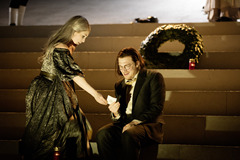| Opera Reviews | 1 May 2024 |
Capriccio stripped bare of its Rococo settingby Moore Parker |
|
| Strauss, R : Capriccio Theater an der Wien 25 April 2016 |
|
|
First performed in Munich in 1942, Capriccio was to become Richard Strauss’ last opera. Vienna’s latest production follows the original version, eliminating the interval which was later introduced, and resulting in a show of some two-and-a-half hours. A steeply-raked rear stage is served by a flight of formidable steps decorated sparsely with military knapsacks, occasional pieces of weaponry, 3 harpsichords, a large wreath centre stage, and the occasional grave lantern. The Countess and her brother regard the other leading protagonists - initially corpses in various military uniforms and positioned on different levels - that come to life in their blood-stained attire as the evening proceeds. Moments of symbolism include the pair of Italian singers, donned to represent Japan and Italy (both countries united with Germany in WW2’s Axis Alliance) and the molestation of an innocent young ballerina, whose life-sized replicate cloth doll ultimately suffers dismemberment and total destruction by some of the male leads. The Countess enters for her final monologue veiled in mourning and combat boots - and rather than addressing her reflection in the customary mirror, is handed an LP recording of the opera Capriccio. Without eclipsing memories of earlier performances musically, this version nevertheless reaches a respectable standard with a truly fine cast. Maria Bengtsson copes valiantly with her unflattering dress and clumsy boots as she negotiates Henrik Ahr’s (Set Designer) daunting steps. Bengtsson’s creamy soprano has just the right colour and plasticity for Strauss and the ideal weight for this venue - and she delivers some wonderfully poised moments in the great finale. Lars Woldt is a characterful and vocally imposing La Roche - displaying superb diction to underscore his interpretation. Tanja Ariane Baumgartner’s warm-timbred Clairon grows as the evening progresses, but - like the Countess - is hardly advantaged as a stage figure in this concept. Equally delightful and vocally impressive are Elena Galitskaya and Jörg Schneider as the two Italian singers, with a strong line-up for the eight servants in a cast well-complimented by Christoph Seidl’s non-nonsense Major-Domo and Erik Årman’s nonplussed Monsieur Taupe. Bertrand de Billy draws disciplined, solid playing from the Vienna Symphony Orchestra and steers an unflinchingly accurate course with his colleagues on the stage throughout the evening.
|
|
| Text ©
Moore Parker Photo © Herwig Prammer |

 Wrenched from its late Parisian Rococo setting to a stark graveyard of century-spanning war victims and their remnants, director Tatjana Gürbaca (in her first Theater and der Wien presentation) attempts to transcribe Strauss’ “Conversation piece for Music” (as it’s subtitled in the score) into a fatalistic reflection on thematic issues dominating the period of the work’s origin - propelling the discourse into realms that feasibly neither the work’s creators intended, nor (according to reaction at the production’s premiere) that current paying guests possibly desire.
Wrenched from its late Parisian Rococo setting to a stark graveyard of century-spanning war victims and their remnants, director Tatjana Gürbaca (in her first Theater and der Wien presentation) attempts to transcribe Strauss’ “Conversation piece for Music” (as it’s subtitled in the score) into a fatalistic reflection on thematic issues dominating the period of the work’s origin - propelling the discourse into realms that feasibly neither the work’s creators intended, nor (according to reaction at the production’s premiere) that current paying guests possibly desire. 





